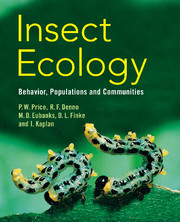Book contents
- Frontmatter
- Contents
- Preface
- Acknowledgments
- Part I Introduction
- Part II Behavioral ecology
- Part III Species interactions
- 4 Plant and herbivore interactions
- 5 Lateral interactions: competition, amensalism and facilitation
- 6 Mutualisms
- 7 Prey and predator interactions
- 8 Parasite and host interactions
- Part IV Population ecology
- Part V Food webs and communities
- Part VI Broad patterns in nature
- Glossary
- References
- Author Index
- Taxonomic Index
- Subject Index
- Plate section
- References
8 - Parasite and host interactions
from Part III - Species interactions
Published online by Cambridge University Press: 05 June 2012
- Frontmatter
- Contents
- Preface
- Acknowledgments
- Part I Introduction
- Part II Behavioral ecology
- Part III Species interactions
- 4 Plant and herbivore interactions
- 5 Lateral interactions: competition, amensalism and facilitation
- 6 Mutualisms
- 7 Prey and predator interactions
- 8 Parasite and host interactions
- Part IV Population ecology
- Part V Food webs and communities
- Part VI Broad patterns in nature
- Glossary
- References
- Author Index
- Taxonomic Index
- Subject Index
- Plate section
- References
Summary
When considering the word “parasite” various kinds of organisms may spring to mind, depending upon the audience. Veterinarians may think of scabies, mange mites, warble flies, helminthes such as liver flukes, bird lice and disease organisms that cause rabies, plague, West Nile Virus and bird flu. Medical entomologists may be more concerned about malaria, sleeping sickness and vectors of disease like mosquitoes and blackflies. Agriculturalists would perhaps worry about plant pathogenic diseases and nematode parasites. Those involved with the biological control of weeds or insect herbivores may well think of diseases of plants and insects, and parasitoid wasps and flies. But springing to mind among only a few insect ecologists, perhaps, would be the insect herbivores themselves: caterpillars of the moths, butterflies and sawflies, larvae of chrysomelid beetles, bark beetles, weevils, grubs of root-feeding insects such as rootworms, and wood-boring larvae, such as cerambycid and buprestid beetles, and clearwing and carpenter moths. And yet, when the definition of the term parasite is appreciated, we can begin to recognize the vast convergence of many lineages toward the parasitic way of life. In common usage is the term “host plant” for insect herbivores, with the clear implication that plants are hosts to parasites. Explicit recognition of herbivorous insects as parasites is provided in the definition of a gall: “Galls are abnormal growths formed from tissues of a plant or other host, due to the parasitic activity of another organism” (Redfern and Shirley 2002, p. 207). This broad view of what is a parasite is somewhat controversial because of the ingrained emphasis on parasites of animals, particularly in the field of parasitology. However, plant pathology treats parasitic diseases extensively and we can observe life-history convergence in parasites on animals and plants (Section 8.6), so we should recognize the common features of all kinds of parasites.
In this chapter we emphasize the diversity of insect parasites, as well as the convergence of many groups toward similar life cycles, their main characteristics and how they relate to host species. We compare parasites with other ways of life such as predation, emphasizing that intimacy and duration of relationships between parasite and host have major importance in understanding evolutionary pathways in parasite lineages: life-history convergence, adaptive radiation and phylogenetic tracking of host lineages. Kinds of damage inflicted on hosts are discussed. Host responses in the form of defenses, how parasites can modify host behavior, and the population dynamics of host and parasite all contribute to a general appreciation of the parasite's ecological and evolutionary roles.
- Type
- Chapter
- Information
- Insect EcologyBehavior, Populations and Communities, pp. 304 - 348Publisher: Cambridge University PressPrint publication year: 2011



